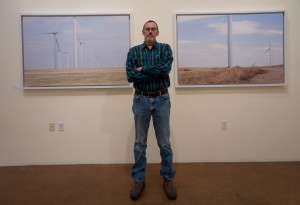Tags
Related Posts
Share This
Asking Questions

Kevin O’Connell’s photographs challenge viewers to examine the mainstream consensus of alternative energy.
“What have we traded away by basing economies on unyielding consumption?” asks Denver-based photographer Kevin O’Connell. Despite the question, O’Connell’s photography exhibit “Everything Comes Broken,” currently featured in the Marion Center for Photographic Arts, isn’t a political statement, nor should it be considered activism. O’Connell’s photographs are a platform for an ongoing dialogue regarding the future of energy—not only in our nation, but across the world. Questions arise to what exactly this phenomenon of energy production is really worth.
O’Connell began photographing after graduate school. During a move from Chicago to Denver, he was astonished by the vastness and space of the Midwest. He began to approach photography like many following in the footsteps of the “masters” of photography (Robert Adams, Paul Strand, Minor White, etc.) by making a series of black and white photographs, many in the traditional platinum palladium process.
O’Connell spent the next 10 years photographing the plains of Colorado in what he describes as essentially “nothing.”
“My photographs then were very graphic and very much about lines and space,” he says. After many attempts and visits to the same sites, he began to look beyond the plains and see the objects that were as much a part of the landscape as space.

O”Connell discusses his personal experiences with making and exhibiting his work with SFUAD photography students.
What he didn’t realize initially is how the 9/11 attacks would change the plains. Following 9/11 and the invasion of Iraq, the world by necessity became increasingly interested in energy, particularly when the demand of oil by the expansion of third world economies sent prices soaring. At the same time the search for alternative energies began to boom, one was wind power.
The plains of Colorado along with other regions of the United States gave way to energy “hotspots.” “It disturbed me,” O’Connell says in reference to the number of wind farms establishing themselves at a rapid pace. “It was my backyard and I was very defensive of it.” It should be noted that most of the energy produced at these wind farms in Colorado is sent to the east coast.
O’Connell compares the experience of being on a wind farm to Edmund Burke’s concept of the sublime.
“Being there is overwhelming and kind of creepy,” he says, “you’re the only one out there but it isn’t quiet, the sound bends.“ This experience led him to create an indistinguishable view of wind farms.
His images of one such farm brings the viewer all the way from the edge of the plains into the nuts and bolts of a wind turbine, all within the aesthetic of a soft pastel color palette. In addition, since viewers cannot hear the experience directly through the photographs, O’Connell has included two looped video installations of wind turbines in action including their unique sound.
“I don’t have any answers,” he says, referring to the energy crisis. For O’Connell, his ultimate goal with this or what he believes that any artist’s work should do is “make people think about it for themselves, rather than accept the public discourse we normally get.”
Atrium Gallery at the Marion Center for Photographic Arts
Santa Fe University of Art and Design
1600 St. Michael’s Drive, Santa Fe
Free and open to the public. The O’Connell exhibition will run through Saturday, May 17, and will be viewable Monday through Friday from 9 a.m. to 5 p.m. The Monte del Sol student exhibition will run through Friday, Feb. 28. For more information, contact Sharon Russell at 1-505-473-6341.






 Jackalope Magazine is the student magazine of Santa Fe University of Art and Design. Building on the interdisciplinary nature of our education, we aim to showcase the talent of our university and character of our city.
Jackalope Magazine is the student magazine of Santa Fe University of Art and Design. Building on the interdisciplinary nature of our education, we aim to showcase the talent of our university and character of our city.
Recent Comments